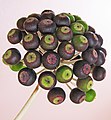Fatsia japonica: Difference between revisions
m fix citations |
Rescuing 1 sources and tagging 0 as dead. #IABot (v1.5.4) |
||
| Line 15: | Line 15: | ||
|}} |
|}} |
||
'''''Fatsia japonica'''''([[synonym (taxonomy)|syn.]] ''Aralia japonica'' [[Carl Peter Thunberg|Thunb.]], ''A. sieboldii'' [[Hort.]] ex [[K.Koch]]), also '''glossy-leaf paper plant''',<ref name=":0">{{Cite book|url=http://www.forest.go.kr/kna/special/download/English_Names_for_Korean_Native_Plants.pdf|title=English Names for Korean Native Plants|last=Korea National Arboretum|publisher=National Arboretum|year=2015|isbn=978-89-97450-98-5|location=Pocheon|pages=347|access-date=27 November 2016|via=Korea Forest Service}}</ref> '''fatsi''', '''paperplant''' or '''Japanese aralia''', is a [[species]] of [[flowering plant]] in the [[family (biology)|family]] [[Araliaceae]], [[native plant|native]] to southern [[Japan]], southern [[Korea]], and [[Taiwan]]. |
'''''Fatsia japonica'''''([[synonym (taxonomy)|syn.]] ''Aralia japonica'' [[Carl Peter Thunberg|Thunb.]], ''A. sieboldii'' [[Hort.]] ex [[K.Koch]]), also '''glossy-leaf paper plant''',<ref name=":0">{{Cite book|url=http://www.forest.go.kr/kna/special/download/English_Names_for_Korean_Native_Plants.pdf|title=English Names for Korean Native Plants|last=Korea National Arboretum|publisher=National Arboretum|year=2015|isbn=978-89-97450-98-5|location=Pocheon|pages=347|access-date=27 November 2016|via=Korea Forest Service|deadurl=yes|archiveurl=https://web.archive.org/web/20170525105020/http://www.forest.go.kr/kna/special/download/English_Names_for_Korean_Native_Plants.pdf|archivedate=25 May 2017|df=}}</ref> '''fatsi''', '''paperplant''' or '''Japanese aralia''', is a [[species]] of [[flowering plant]] in the [[family (biology)|family]] [[Araliaceae]], [[native plant|native]] to southern [[Japan]], southern [[Korea]], and [[Taiwan]]. |
||
It is an [[evergreen]] [[shrub]] growing to {{convert|1|-|3|m|abbr=on}} tall, with stout, sparsely branched stems. The [[leaf|leaves]] are spirally-arranged, large, {{convert|20|-|40|cm|abbr=on}} in width and on a petiole up to {{convert|50|cm|abbr=on}} long, leathery, palmately lobed, with 7–9 broad lobes, divided to half or two-thirds of the way to the base of the leaf; the lobes are edged with coarse, blunt teeth. The [[flower]]s are small, white, borne in dense terminal compound [[umbel]]s in late autumn or early winter, followed by small black [[fruit]] in spring. |
It is an [[evergreen]] [[shrub]] growing to {{convert|1|-|3|m|abbr=on}} tall, with stout, sparsely branched stems. The [[leaf|leaves]] are spirally-arranged, large, {{convert|20|-|40|cm|abbr=on}} in width and on a petiole up to {{convert|50|cm|abbr=on}} long, leathery, palmately lobed, with 7–9 broad lobes, divided to half or two-thirds of the way to the base of the leaf; the lobes are edged with coarse, blunt teeth. The [[flower]]s are small, white, borne in dense terminal compound [[umbel]]s in late autumn or early winter, followed by small black [[fruit]] in spring. |
||
Revision as of 20:37, 28 September 2017
| Fatsia japonica | |
|---|---|

| |
| Scientific classification | |
| Kingdom: | |
| (unranked): | |
| (unranked): | |
| (unranked): | |
| Order: | |
| Family: | |
| Genus: | |
| Species: | F. japonica
|
| Binomial name | |
| Fatsia japonica | |
Fatsia japonica(syn. Aralia japonica Thunb., A. sieboldii Hort. ex K.Koch), also glossy-leaf paper plant,[1] fatsi, paperplant or Japanese aralia, is a species of flowering plant in the family Araliaceae, native to southern Japan, southern Korea, and Taiwan.
It is an evergreen shrub growing to 1–3 m (3 ft 3 in – 9 ft 10 in) tall, with stout, sparsely branched stems. The leaves are spirally-arranged, large, 20–40 cm (7.9–15.7 in) in width and on a petiole up to 50 cm (20 in) long, leathery, palmately lobed, with 7–9 broad lobes, divided to half or two-thirds of the way to the base of the leaf; the lobes are edged with coarse, blunt teeth. The flowers are small, white, borne in dense terminal compound umbels in late autumn or early winter, followed by small black fruit in spring.
The name "fatsi" is an approximation of the old Japanese word for 'eight' (hachi in modern Japanese), referring to the eight lobes. In Japan it is known as yatsude, meaning "eight fingers". The name "Japanese aralia" is due to the genus formerly being classified within a broader interpretation of the related genus Aralia in the past. It has been interbred with Hedera helix (common ivy) to produce the intergeneric hybrid × Fatshedera lizei.
Cultivation and uses
It is commonly grown as an ornamental plant in warm temperate regions where winters do not fall below about -15°C (5°F). F. japonica have been shown to effectively remove gaseous formaldehyde from indoor air.[2]
This plant[3] and its cultivar F. japonica 'Variegata'[4] have gained the Royal Horticultural Society's Award of Garden Merit.
Naturalisation
While grown as a landscaping plant, it has also become naturalised in some areas. In New Zealand it has become established in waste areas and abandoned gardens, spreading via suckers.
Health
The sap, which is sticky and resinous, can cause contact dermatitis in sensitive people.
-
Fruiting body
-
A small Fatsia japonica leaf
-
Close-up of flower umbel
References
- ^ Korea National Arboretum (2015). English Names for Korean Native Plants (PDF). Pocheon: National Arboretum. p. 347. ISBN 978-89-97450-98-5. Archived from the original (PDF) on 25 May 2017. Retrieved 27 November 2016 – via Korea Forest Service.
{{cite book}}: Unknown parameter|deadurl=ignored (|url-status=suggested) (help) - ^ "Efficiency of Volatile Formaldehyde Removal by Indoor Plants: Contribution of Aerial Plant Parts versus the Root Zone". Journal of the American Society for Horticultural Science. 133 (4): 521–526. July 2008. ISSN 0003-1062.
{{cite journal}}: Unknown parameter|authors=ignored (help) - ^ "RHS Plant Selector - Fatsia japonica". Retrieved 19 June 2013.
- ^ "RHS Plant Selector - Fatsia japonica 'Variegata'". Retrieved 19 June 2013.
Further reading
- Huxley, A., ed. (1992). New RHS Dictionary of Gardening. Macmillan.
- BBC Gardening: Fatsia japonica
- Poplay, I. et al. (2010). "An illustrated Guide to Common Weeds Of New Zealand" 3rd ed. Pg. 36



